
A derelict sail boat washed up on a local beach from a winter storm a couple of years ago. It is polluting the beach and bay as it sheds particles from its fiberglass hull. Plastic decking has come off the bow and a number of other plastic items are wedged under the boat, not to mention the numerous cans of spray paint used to tag this mess.
We are all acutely aware that our oceans and lakes are becoming contaminated by discarded plastics among other toxins and debris. This problem is world-wide and like all politics, the solution must start locally. In this diary I will highlight the state of our local beaches that I frequent often along Bellingham Bay. Our Bay is part of the Salish Sea lying between the northern edge of Puget Sound and the Strait of Georgia which lies largely in Canada. Our local trash is a small but important part of the larger global plastics debris problem that is predicted to triple in just the next decade. The global issue of plastics pollution is monumental. I recognize that I can only touch on it here and as many know this issue is important enough that it is the focus of 2018 Earth Day.
Much of the trash afloat in our oceans congregates within oceanic gyres, or large scale currents creating an enormous vortex like those shown below in the Pacific Ocean. An ocean gyre is a system of circulating ocean currents formed by the Earth’s wind patterns and the forces created by the rotation of the planet. The centers of these gyres are areas of calm where the material accumulates. There are five such garbage patches around the globe but the Pacific remains the largest.
Pacific Ocean gyre containing the Great Pacific Garbage Patch, (there are also patches in other oceans.
(Illustration attribution, NOAA)
The garbage patch, primarily plastics (polyethylene and polypropylene), has accumulated over many years but it continues to grow at an alarming rate. The Pacific Garbage Patch acquires its garbage largely from land sources (~80%), in North America and Asia . (It is estimated that 10 -20% of the current Pacific Patch is from the Japanese tsunami of 2011.) The remaining 20% comes from fishing vessels, offshore rigs, and large cargo ships that dump their trash intentionally or lose it during storms. The major part, about 46% of the ocean-sourced debris mass is megaplastics and derelict fishing nets, also referred to as ghost nets from ocean trawlers.
Some of the stranger ship cargoes lost at sea during the 1990s include five containers of Nike shoes, 10s of thousands of rubber duckies, legos, computer monitors, and 24,000 pieces of hockey gear. Many of these items washed up on the shores of north America and made for great beach combing.
The huge collections of ocean garbage are actually larger than one sees if sailing though them as 40 to 50% sinks to the bottom. Apparently it is possible to sail through these garbage dumps and not see a bit of it – but much is still there in the form of micro plastics.
Although the Pacific Garbage Patch, like that in all of our major bodies of water contains all sorts of items, the most prevalent, long lasting, and pernicious is the various types of plastics and particularly, Microplastics.
Micro plastic:
Some plastics degrade when exposed to sunlight whereas others simply erode. However, they do not disappear. Rather they simply break down into smaller units. Those degraded particles less than 5 mm in length are referred to as microplastic.
Microplastics can’t always be seen by the naked eye. Even satellite imagery doesn’t show a giant patch of garbage. The microplastics of the Great Pacific Garbage Patch can simply make the water look like a cloudy soup. This soup is intermixed with larger items, such as fishing gear and shoes.
Micro plastics make up a large portion of the plastic pollution problem, world wide and locally. Much remains afloat but a significant amount sinks to the bottom or washes up on beaches and is thus, not readily observable.
A University of Washington oceanography student recently did a senior thesis looking at such microplastics on 12 Puget Sound beaches. Each sample contained microplastics at an average of 1,776 pieces per 3-foot-square sampling plot. The largest portion of the microplastics (73%) were from polyester fibers including polar fleece. These fibers come through the laundry and are so small as to avoid filtration, eventually washing through water treatment plants and into the salt water. One recent study demonstrated that top load washing machines produced 7 times the amount of fiber release as did front load washers.
These fibers are also found along rivers running into the sound.
Local garbage and plastic pollution.
So there is a brief overview of the plastic pollution situation on a global level and it is huge. However, it starts somewhere. Recall that 80% of the Garbage Patch is land based which means that it starts at home. And that is in fact what I found on our beaches.
To see what was happening in our own area, I took walks that covered five of our local beaches along Bellingham Bay. I picked up what trash I could carry and photographed other debris that I could not extract from the beaches. I expected our beaches to be pretty good as we tend to think of ourselves as very well informed and environmentally conscious and we are big on recycling. In fact, from a distance the beaches looked pretty clean.
On closer inspection I found that we too were contributing to the larger problem. The items found were largely plastic products seen in the Great Pacific Garbage Dump. As is the case for the ocean, is also for here, but of course on a very smaller scale.
Plastic detritus that I picked up on a couple of our beaches. These items will be with us for the long haul.
Among the trash items I found were sections of fishing net on two beaches which was not surprising as this is a fishing port and miles of nets are strung and repaired along the bay in preparation for season openings. Similarly, I found pieces of boat-related fiberglass, and polyethylene lines and tarps, along with various items of clothing, mostly of synthetic fibers. The consistent finding was plastic bags of various sizes and plastic, glass and metal drink containers. Coffee cups and candy wrappers too were found on each of the beaches. Consistent with the research on ocean trash, most is land based as is evident in the photo.
As families of River Otters are often seen frolicking on two of these beaches, the pieces of fish net were particularly unwelcome.
As evidence of otters’ activity, I found a couple of freshly dead flat fish tucked into some rocks on one of the beaches. They had bites taken out of their bellies, about the size I would expect from a river otter (photo tot he right). 
I hope they are wary enough to avoid the netting that is just around the corner.
The smallest beach I visited was essentially a “pocket Beach” only about 20 yards long. This beach did not have too much plastic litter but was covered with glass fragments, some of which had been smoothed by the tides on the rocky shore but most of which was still raw and jagged. It was not a beach to romp on without something on your feet. It is the site of a former garbage dump and casually called “Glass Beach.”
 Glass Beach with a few clam shells and some plastic
Glass Beach with a few clam shells and some plastic
One issue around here on a couple of the beaches is that they are often inhabited by homeless people who set up camp along the shore. Although this is somewhat of a problem, it is nothing like tent cities that pop up in many metropolitan areas although the trash can be substantial. The Parks Department works with a police division that monitors the encampments and tends to the trash but it is difficult to get it all.
The health effects of this plastic in the water that are known are potentially huge and there is much more to be learned, especially of the effects of humans and animals ingesting microplastics. Ill affects are likely to be found across most species associated with large bodies of water and up and down the food chain.
Animal life in the ocean and along the shores are the most obvious victims of this pollution. The micro plastics in the large garbage patches in the oceans muddy the water, decrease sun light and reduce photosynthesis of plant life such as plankton and by extension limits all organisms that feed on it.
mattress and other debris
Sea life of all sizes are affected by becoming entangled in the various plastics. For example, loggerhead turtles are known to mistake plastic bags for their favorite food- jellies.
.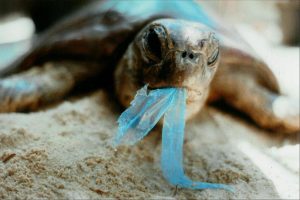 Albatrosses mistake microplastics for fish eggs and feed them to their young, which in turn die from starvation with a stomach full of plastic.
Albatrosses mistake microplastics for fish eggs and feed them to their young, which in turn die from starvation with a stomach full of plastic.
Turtle eating plastic that looked like jelly fish. What does this do their digestive systems? (Attribution: Plastics Pollution Coalition).
Invertebrates too are involved such as shell fish (oysters, clams) which also ingest these tiny particles. And then we eat them. 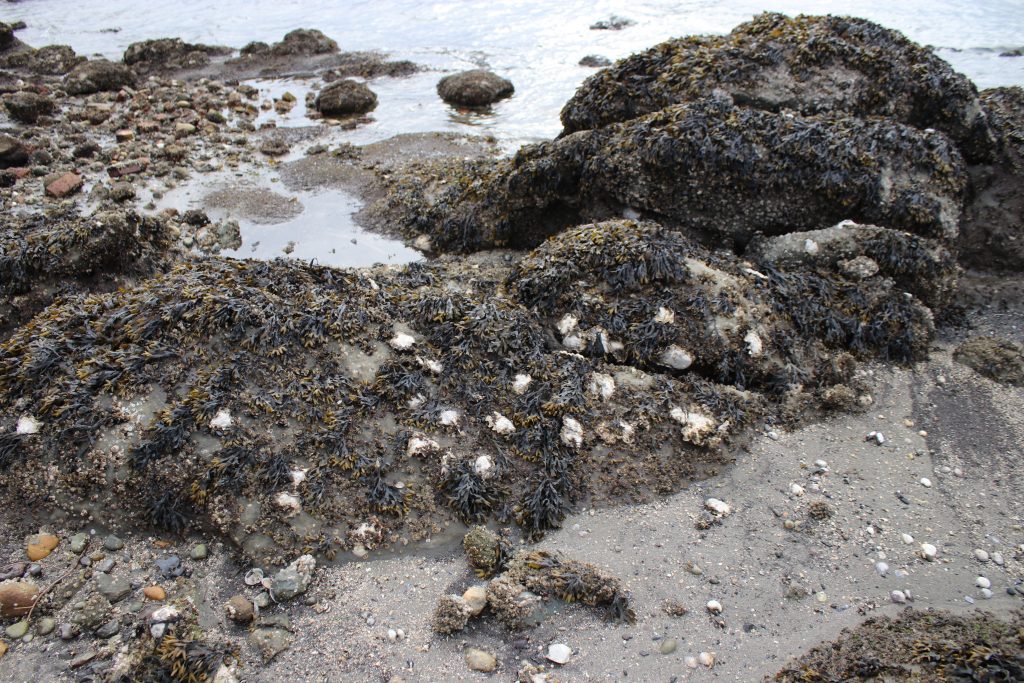
One of the beaches I visited was loaded with oysters that we dare not harvest. These hunks of delicious bivalves are probably toxic and loaded with microplastic. They are ours for the taking, if we dare.
Few people today are immune to the reach of plastic particles. For example, a recent study tested bottled water from 11 different brands, purchased in 19 locations in 9 countries. They found 93% of the bottles showed some sign of microplastic contamination, largely polypropyline, some of which likely came from the packaging or bottling process itself.
What can we do?
As large as the problem is now, it is growing exponentially and it is estimated that the volume will triple in the coming decade!
On the global scale, I see both pessimism and optimism.
Globally, the Garbage patches are too big for any single entity to take on alone. Since they are in the middle of oceans they do not belong to any particular country. As part of an assessment of the enormity of the clean up task, NOAA’s “… Marine Debris Program has estimated that it would take 67 ships one year to clean up less than one percent of the North Pacific Ocean.”
However, another international consortium of ocean experts, “The OceanCleanup” headquartered in The Netherlands, believes that they have a system that that will allow them to clean up 50% of the Great Pacific Garbage Patch in five years and have a clean ocean by 2050. I wish them well and if they can do it, we will all owe them an immense debt of gratitude. The task is enormous.
Our Local Action:
No matter what group or groups take on this herculean task, it can never be accomplished until the sources that continue to feed the garbage patches are cut off or at least significantly reduced.
Which brings us back to issue of local stewardship of our own waters and beaches.
As I noted above, I found a quite a bit of debris, mostly plastic based and even the clothing I found was made of synthetic fibers.
Until we stop the plastic from entering the water, we have little chance of making headway on the larger global issue.
The good news is there are a number of groups working on this at most locales. NOAA is all over it with what they have to work with. They are particularly working with States and other local commissions such as The Northwest Straits Commission and Foundation, located in Bellingham, WA. With NOAA support, they provide training, funding, and stewardship programs to protect and clean up Puget Sound. They partner with numerous local, national and regional groups and the work they have done to date is phenomenal.
More trash from the beach
The Marine Resources Committees and Commission work in collaboration with local, federal, state and tribal governments and non-governmental organizations in our region, including WA Dept of Fish & Wildlife, WA Dept of Natural Resources, City of Bellingham, National Oceanic & Atmospheric Administration, US Geological Survey, Washington Sea Grant, Puget Sound Restoration Fund, Stillaguamish Tribe, Samish Indian Nation, Swinomish Tribe, Tulalip Tribes, Jamestown S’Klallam Tribe and many others.
Surfriders is a national group dedicated to cleaning up beaches and sponsors local chapters across the country. Our local chapter of Surfriders consists of students from Western Washington University’s Huxley College of Environmental Studies. This group has adopted one of the beaches (Locust or Whirlwind) that I visited and thanks to them, it was not in worse shape. They have a number of activities scheduled at various beaches for the coming months. They, along with Northwest Straits Commission are initiating an “Ocean Friendly Restaurant” program in which they will award their “Ocean Friendly” designation to restaurants that reduce their single use plastics.
Our surfriders plan to follow up on some of my observations from other beaches that they visit less regularly. They have a big work party planned for Earth Day, the 21st. This group seems highly activated to attack this problem locally and after graduating, they will be leaders in taking the fight to larger arenas.
Our Bellingham City Parks and Recreation Department too is attuned to the beach garbage issue and it regularly monitors the beach parks and makes rounds to pick up beach trash. This is commendable and without them doing so, we would have real garbage dumps right on the water.
I asked the Parks Department in whose jurisdiction was the derelict sailboat shown at the top and what they planned to do with it. They immediately contacted the Derelict Vessel Removal Program of the Department of Natural Resources. The application for removal is underway. Last minute addendum. I was just informed that that they moved it yesterday, after two years on the beach!!!
This only took a couple of emails and it worked.
A beach as it is supposed to look. This photo was taken right next to the derelict sail boat
These local groups and a number of others at the regional, State, and national levels are actively involved in meeting this crisis. But they need lots of help.
The garbage that I found as shown above, was in addition to what the these various groups and department employees pick up on a regular maintenance basis. Without their regular efforts, I can only imagine what the beaches and the bays would look like.
Another local effort that is gaining steam in many communities is banning single use plastic grocery bags. These are one of the major single contributors to plastic pollution. At this writing Washington State has 16 cities and two counties that have adopted bans on single use plastic bags. A bill to ban them state-wide was submitted in our last legislative session but it did not get sufficient support to pass.
Close by and also on the Salish Sea is Vancouver BC which is currently developing a single-use plastic reduction strategy that is now open for comment. They state that : “Each week, more than two million plastic bags and two million disposable cups are thrown in the garbage in Vancouver” at a cost of $2.5 million a year to pick up.
One further attempt to reduce plastic pollution bears mention. Starbucks which is in our backyard (seattle) (or we in theirs) has recently pledged $10 million over the next three years to research new coffee cups that can be more widely recycled and composted.
Get involved with End Plastic Pollution on Earth Day 2018 and don’t stop there.
Here are a few informative web sites for those interested in exploring further.
www.nytimes.com/… (overview of the GPGP)
www.slate.com/… (good context article showing that the patch is not just one big island of trash)
oceanconservancy.org/… (blog on using ocean trash for art works)
www.cbc.ca/… (Very recent Canadian Broadcasting story on the patch with good graphics)
www.nationalgeographic.org/… (national Geo. overview on the trash patch)

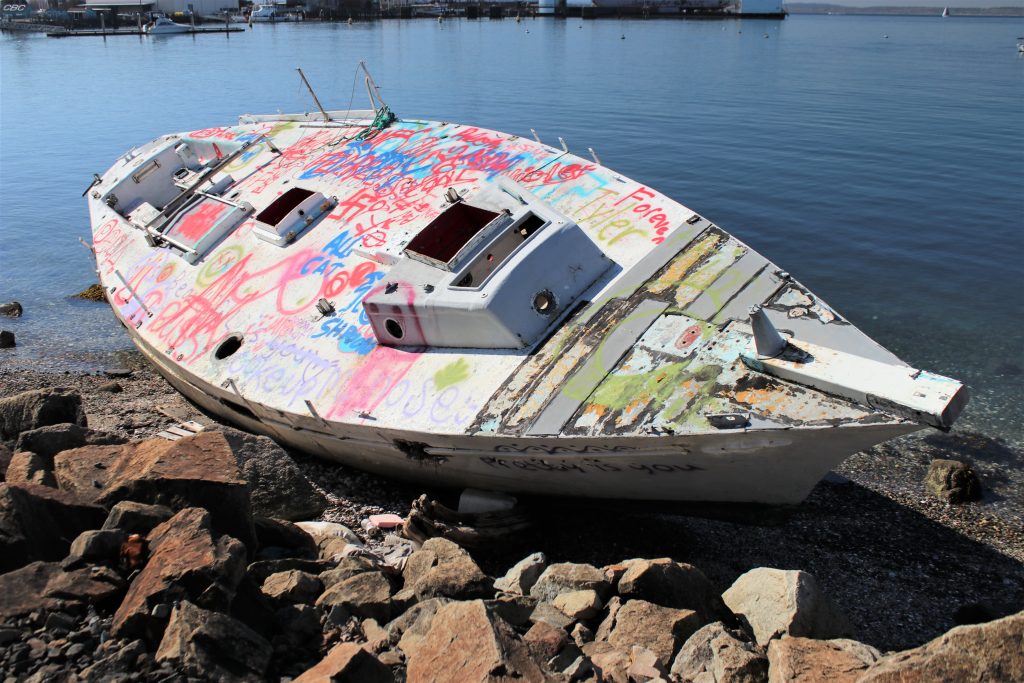
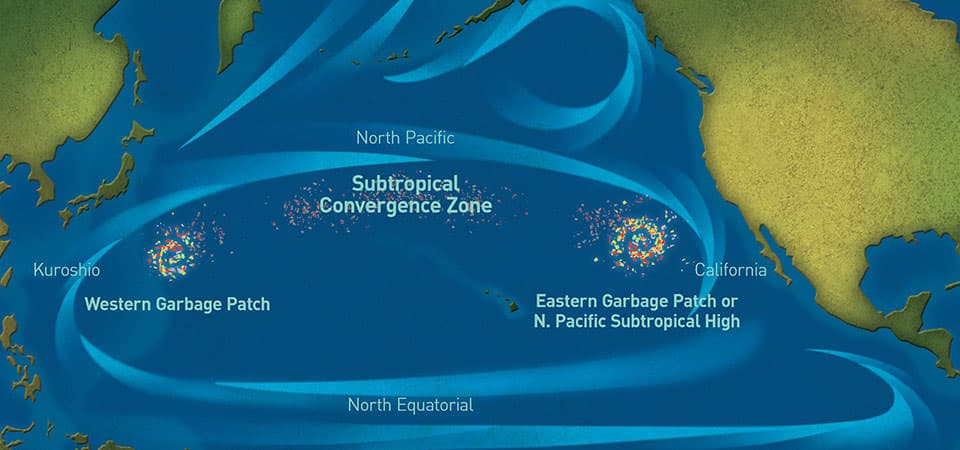

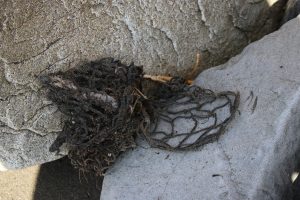
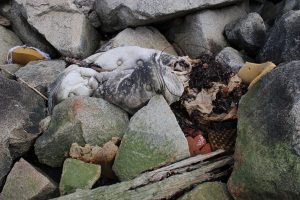
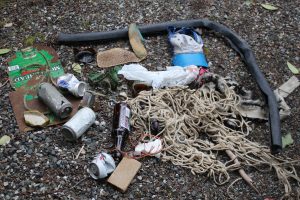
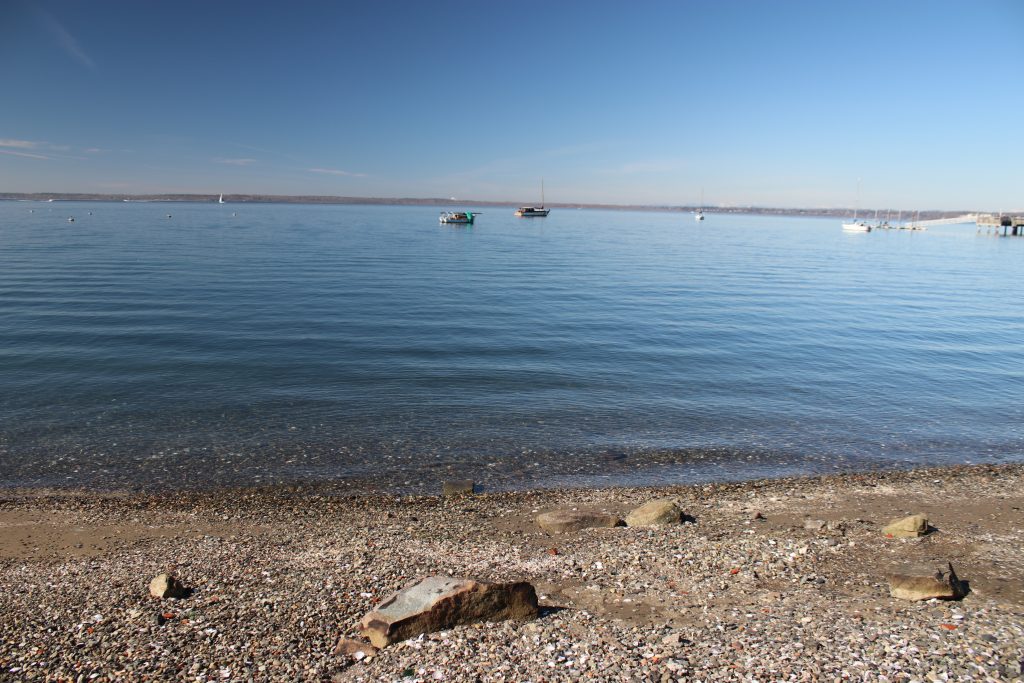
Thanks RonK! I appreciate your care and keeping of Bellingham’s beautiful beaches. Our grand kids are learning important lessons from their involvement with your photo excursions and reporting.
I hope everyone does something for the earth on Saturday: Earth Day 2018!
Thanks, RonK, for your photo diary.
I hope that Earth Day 2018 serves to reminds people of what is at stake when we allow people who hate the planet to take over our government.
Yes, that is probably the most productive thing we can do for the Earth.
{{{RonK}}} – I’ve been aware of the issue for years – it’s so tragic for the wildlife, especially the babies dying of starvation because they’re being fed plastic. Extinction in short order that way. I hope the various groups trying to address this actually get together and pool resources and information. It’s gonna take one heck of a Village to deal with this. But it can be done. If enough of us want it to be and act.
Thank you for the post – awareness comes first. Including the awareness that simply reporting an issue you can’t deal with yourself (like the abandoned boat) can get it dealt with. And that we’ve got to “unplastic” our society. moar {{{HUGS}}}
Thanks Bfitz,
I like the concept and the word of : “unplastic.” We’ll be going up into the mountains to work on salmon stream restoration on Saturday. They need lots of help.
This seems promising. I would hate to see progress here lead to not caring about creating too much plastic but we have a huge mess to clean up right now. I was going to try to find out more because if it “eats” the plastic, what materials are created from that process? Are they harmful?
I too read about this new “bug” that eats plastic. Apparently, it breaks the plastic down into the constituent compounds that it was made from. So, I guess we will be back to petroleum.
Ah, that would make sense. We could hope that the liquid form is easier to break down.